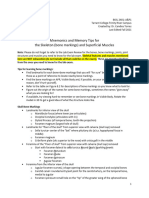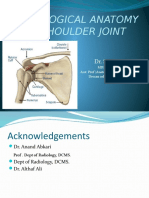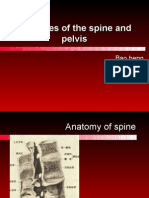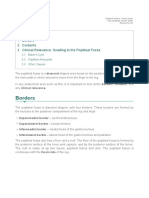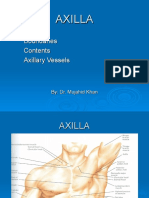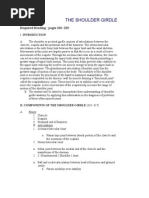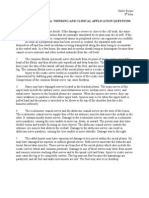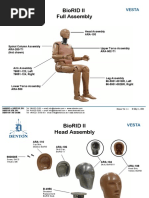K Shoulder 08
K Shoulder 08
Uploaded by
owaiskhan91Copyright:
Available Formats
K Shoulder 08
K Shoulder 08
Uploaded by
owaiskhan91Original Title
Copyright
Available Formats
Share this document
Did you find this document useful?
Is this content inappropriate?
Copyright:
Available Formats
K Shoulder 08
K Shoulder 08
Uploaded by
owaiskhan91Copyright:
Available Formats
國立台灣大學物理治療學系九十七學年度/ 肌動學 36
UPPER EXTREMITY – The Shoulder Complex
教學目標: 修習本課後, 學生應可
1. 區別肩帶與肩關節的基本構造, 包括關節型態、關節形狀與相關韌帶與肌肉
2. 描繪肩部的動作學、相關之肌肉活動、與牽制動作的因子
3. 理解肩部維持穩定及造成傷害的機轉
4. 分辨三自由度動作的關節與一自由度動作或二自由度動作的關節之異同
5. 瞭解肌肉間相互合作及單一肌肉損傷或肌力不足的影響
必讀書籍:
1. Neumann DA (2002). Shoulder complex. In Neumann DA: Kinesiology of the
Musculoskeletal System: Foundations for Physical Rehabilitation. Philadelphia: Mosby.
Chapter 5, pp. 91-132
2. Smith LK, Weiss EL, Don Lehmkuhl L (eds, 1996). Brunnstrom's Clinical Kinesiology, 5th
ed. Philadelphia, F.A. Davis. Chapter 5
3. Craig J et al. (2001). Biomechanics of the shoulder. In Nordin M & Frankel VH: Basic
Biomechanics of the Musculoskeletal System. Philadelphia: Lippincott Williams &
Wilkins. Chapter 12, pp.318-339
Functions of the Shoulder
1. to link the upper extremity to the trunk
2. to provide mobility of the arm in space
3. to provide stability for elbow and hand skillful or forceful movements
Structures of the Shoulder Complex
A. Component of the shoulder joint and shoulder
girdle
1. glenohumeral joint (shoulder joint)
a. proximal component: concave glenoid fossa
covered with glenoid labrum
b. distal component: convex humeral head
c. joint type: ball-and-socket joint
d. motion: convex on concave
-- shoulder flexion/ extension with posterior/ anterior glide of the humeral head
-- shoulder abduction/ adduction with inferior/ superior glide of the humeral head
-- shoulder internal/ external rotation with posterior/ anterior glide of the humeral head
HC\Kinesiology\kShoulder08.doc 36 Nov 04, 2008
國立台灣大學物理治療學系九十七學年度/ 肌動學 37
UPPER EXTREMITY – The Shoulder Complex
e. DOF = 3
f. resting position: 70° of shoulder abduction and 30° of flexion (horizontal adduction)
g. closed packed position: 90° of shoulder abduction and full external rotation
2. sternoclavicualr joint
a. proximal component: saddle-shaped medial end of the clavicle
b. distal component: saddle-shaped sternal manubrium
c. joint type: saddle joint
d. motion: clavicle elevation/ depression
clavicle protraction/ depression
clavicle posterior rotation
e. DOF = 3
3. acromioclavicular joint
a. proximal component: convex lateral end of the clavicle
b. distal component: concave acromion of the scapula
c. joint type: nearly plane joint
d. motion: scapula winging – medial border of the scapular moves backwards
scapula tipping – inferior angle of the scapula moves backwards
scapula upward/ downward rotation – inferior angle of the scapula rotates upwards/
downwards
e. DOF = 3
4. scapulothoracic articulation
a. proximal component: convex rib cage
b. distal component: concave anterior surface of the scapula
c. motion: shoulder girdle motion; concave on convex
-- scapular elevation/ depression: whole scapula moves upwards/ downwards
-- scapular abduction/ adduction: medial border of the scapula moves away from/ toward
the spine
-- scapular upward/downward rotation: inferior angle of the scapula rotates
upwards/downwards
d. DOF = 3
e. functions of the scapulothoracic articulation
-- to provide movement base for the humerus
-- to maintain length-tension relationship for the deltoid muscle to function above 90º of arm
elevation
-- to provide stability of the GH joint working overhead
-- to absorb the shock for forces applied to the outstretched arm
-- to permit push-up during crutch walking
5. suprahumeral articulation (subacromial joint): not for joint stability
HC\Kinesiology\kShoulder08.doc 37 Nov 04, 2008
國立台灣大學物理治療學系九十七學年度/ 肌動學 38
UPPER EXTREMITY – The Shoulder Complex
-- coracoacromial arch: composed of the coracoacromial ligament
-- spraspinatus tendon passing underneath this arch
-- subacromial bursa
-- shoulder impingement occurs if the subacromial space is insufficient
6. bicipital groove covered with transverse humeral ligament
-- groove between greater and lesser tuberosities of the humerus covered with transverse
humeral ligament
-- passing tendon of long head of biceps brachii
-- intra-articular but extra-synovial
B. Plane of scapula
1. the plane at the angle of 30º anterior to the frontal plane
2. capsules in the loose-packed position
3. no impingement in the suprahumeral joint if shoulder motions occurs in the plane of scapula
C. Dependent arm position
-- the position that the arm is hanging down by the side of the trunk
Kinematics of the Shoulder Complex
A. Shoulder flexion/ extension in the sagittal plane
1. joint involved: GH (principal joint), SC, and AC joints and ST articulation
2. axis: transverse axis through the center of the humeral head
3. osteokinematic movements
-- range: 0-180 for flexion and 0-45 or 60 for extension
-- closed kinematic chain motions:
4. arthrokinematic movements
-- posterolateral glide of the humeral head on the glenoid cavity with shoulder flexion
-- anteromedial glide of the humeral head on the glenoid cavity with shoulder extension
5. factors limiting shoulder flexion
-- inferior glenohumeral ligament (most important)
-- tightness of the posterior joint capsule
6. factors limiting shoulder extension
-- superior and middle glenohumeral ligament (most important)
B. Shoulder abduction/ adduction in the frontal plane
1. shoulder abduction = arm elevation
HC\Kinesiology\kShoulder08.doc 38 Nov 04, 2008
國立台灣大學物理治療學系九十七學年度/ 肌動學 39
UPPER EXTREMITY – The Shoulder Complex
2. joint involved: GH (principal joint), SC, and AC joints and ST articulation
3. axis of rotation
GH joint: sagittal axis through the center of the humeral head
SC joint: sagittal axis through the center of the medial end of the clavicle
4. osteokinematic movements
-- range of motion (ROM)
total range: 0-165 or 175º
GH joint: 0-120º of shoulder abduction
0-60º with full internal rotation of humerus
0-90º with full external rotation of humerus
SC joint: 0-30 or 45º, most occurring in 1st 90º of arm elevation
-- scapulohumeral rhythm
Inman et al. (1944): measured frontal plane motion
• GH: ST = 2:1 after 30º of abduction
Bagg and Forrest (1988): measured plane of scapula motion
• GH: at the beginning and the end
• ST: 80-140 º of abduction
• averaged ratio: 1.25:1
-- Codman’s paradox: conjunct rotation occurs during sequential motion
5. arthrokinematic movements
-- shoulder abduction
inferior glide of the humeral head on the glenoid cavity
inferior glide of the clavicle on the sternum in most people
6. factors limiting shoulder abduction
a. inferior glenohumeral ligament (most important)
b. tightness of the inferior joint capsule of the glenoumeral joint
c. tightness of the costoclavicular and interclavicular ligaments and the subclavicius muscles
at the SC joint
7. factors limiting shoulder adduction : trunk
C. Shoulder external/ internal rotation
1. joint involved: glenohumeral joint
2. axis of rotation: vertical axis through the center of the humeral head
3. osteokinematic movements
-- range of motion (ROM)
shoulder internal rotation: 0-70º as the arm at 90º of shoulder abd and 90º elbow flexion
shoulder external rotation: 0-90º as the arm at 90º of shoulder abd and 90º elbow flexion
If the elbow is extended, shoulder rotation occurs simultaneously with forearm rotation.
HC\Kinesiology\kShoulder08.doc 39 Nov 04, 2008
國立台灣大學物理治療學系九十七學年度/ 肌動學 40
UPPER EXTREMITY – The Shoulder Complex
4. arthrokinematic movements
posterolateral glide of the humeral head on the glenoid cavity with shoulder internal rotation
anteromedial glide of the humeral head on the glenoid cavity with shoulder external rotation
5. factors limiting shoulder internal rotation: posterior capsule
6. factors limiting shoulder external rotation
-- coracohumeral ligament
-- glenohumeral ligaments
D. Shoulder horizontal abduction/ adduction
1. shoulder flexion/ extension at 90º of shoulder abduction
-- horizontal abduction: arm moves backward with the arm at 90º of shoulder abduction
-- horizontal adduction: arm moves forward with the arm at 90º of shoulder abduction
2. joint involved: GH, SC, and AC joints as well as ST articulation
3. plane of motion: transverse plane
4. axis of rotation: vertical axis through the center of the humeral head
5. arthrokinematic movements
-- anteromedial glide of the humeral head on the
glenoid cavity with shoulder horizontal depression
abduction
-- posterolateral glide of the humeral head on the
glenoid cavity with shoulder horizontal
elevation
adduction
E. Shoulder girdle elevation/ depression
1. elevation: ST elevation associated with SC elevation and AC tipping
2. depression: STdepression associated with SC depression
3. range: 0-30 or 45º for clavicle elevation and 0-15º for clavicle depression
4. sagittal axis of the SC joint
HC\Kinesiology\kShoulder08.doc 40 Nov 04, 2008
國立台灣大學物理治療學系九十七學年度/ 肌動學 41
UPPER EXTREMITY – The Shoulder Complex
F. Shoulder girdle protraction/ retraction
1. 0-15º for protraction and 0-15º for retraction
2. clavicular protraction associated with scapular abduction
3. clavicular retraction associated with scapular adduction
4. vertical axis of the sternoclavicular joint protraction
G. Scapulothoracic upward rotation
1. fisrt 30º: elevation of the clavicle through the axis at the
base of the spine of scapula
2. last 30º: posterior rotation of the clavicle and scapular retraction
rotation around AC joint downward
rotation
H. Scapulothoracic winging
1. posterior movement of the vertebral (medial) border of the
scapula, coupled with scapular abduction
2. vertical axis at the acromioclavicular joint upward
rotation
Joint stability
A. Stability of glenohumeral joint deltoid SIT
1. glenoid labrum
2. coracohumeral ligament supraspinatus
3. superior capsule
infraspinatus
4. inactive supraspinatus
5. dynamic stability of the rotator cuff subscapularis
teres minor
B. Stability of sternoclavicular joint
1. saddle-shaped articular surface
2. anterior and posterior sternoclavicular ligament
3. costoclavicular ligament
4. interclavicular ligament
C. Stability of acromioclavicular joint
1. acromioclavicular ligament
D. Scapulothoracic articulation:
HC\Kinesiology\kShoulder08.doc 41 Nov 04, 2008
國立台灣大學物理治療學系九十七學年度/ 肌動學 42
UPPER EXTREMITY – The Shoulder Complex
1. atmosphere pressure
2. serratus anterior
3. structures which hold acromioclavicular and sternoclavicular joints
Muscle Action
A. Muscles for shoulder girdle elevation
prime mover: levetor scapula, upper trapezius, and rhomboids
against resistance: sternocleidomastoid
B. Muscles for shoulder girdle depression
prime mover: lower trapezius
C. Muscles for shoulder girdle protraction
prime mover: serratus anterior and pectoralis minor
D. Muscles for shoulder girdle retraction
prime mover: rhomboid and middle trapezius, and
coupled motion of upper and lower trapezius
E. Muscles for shoulder girdle upward rotation
prime mover: serratus anterior and upper trapezius
F. Muscles for shoulder girdle downward rotation
prime mover: levetor scapula and rhomboid
G. Muscles for shoulder flexion
glenohumeral flexion with shoulder girdle elevation
prime mover: anterior deltoid and clavicualr portion of the pectoralis major
against resistance: coracobrachialis and biceps brachii
H. Muscles for shoulder extension
glenohumeral extension with scapular tipping
prime mover: posterior deltoid, latissimus dorsi
against resistance: teres major
I. Muscles for shoulder abduction
HC\Kinesiology\kShoulder08.doc 42 Nov 04, 2008
國立台灣大學物理治療學系九十七學年度/ 肌動學 43
UPPER EXTREMITY – The Shoulder Complex
glenohumeral abduction with glenohumeral inferior glide and shoulder girdle upward rotation
prime mover: deltoid and supraspinatus for glenohumeral abduction
rotator cuff for inferior glide
serratus anterior and upper trapezius for scapular upward rotation
J. Muscles for shoulder adduction
prime mover: latissmus dorsi, sternal part of pectoralis major
against resistance: teres major
K. Muscles for shoulder external rotation
glenohumeral external rotation with shoulder girdle adduction
prime mover: infraspinatus and teres minor
L. Muscles for shoulder internal rotation
glenohumeral internal rotation with shoulder girdle abduction
prime mover: subscapularis, latismus dorsi, anterior deltoid, pectoralis major
against resistance: teres major
HC\Kinesiology\kShoulder08.doc 43 Nov 04, 2008
You might also like
- Nasm Ces Assessment Form - (PDF-31k) DE532E61B87FDocument1 pageNasm Ces Assessment Form - (PDF-31k) DE532E61B87FBint Yahya100% (2)
- Booty X Body by Linn Lowes PDFFDocument14 pagesBooty X Body by Linn Lowes PDFFAshita SharmaNo ratings yet
- Phasic Activity of Intrinsic Muscles of The FootDocument14 pagesPhasic Activity of Intrinsic Muscles of The FootpetcudanielNo ratings yet
- Dumbbell Exercise Poster 11X17 High ResDocument1 pageDumbbell Exercise Poster 11X17 High ResArturo SierraNo ratings yet
- Cervical MusculatureDocument3 pagesCervical Musculaturesimone dumbrellNo ratings yet
- P.E Quiz 1 Ti FinalsDocument142 pagesP.E Quiz 1 Ti FinalsDizon, Sharmaine L.50% (2)
- Bk7001 Ref SampleDocument8 pagesBk7001 Ref SampleDeryanur Arslan100% (3)
- The Elbow ComplexDocument12 pagesThe Elbow ComplextafelaNo ratings yet
- Osteokinematics and Arthrokinematics of The Hip: Nationalfitnesscenter Ko, KwangjunDocument30 pagesOsteokinematics and Arthrokinematics of The Hip: Nationalfitnesscenter Ko, KwangjunSai RamNo ratings yet
- ROM Booklet 07nov2010Document26 pagesROM Booklet 07nov2010his.thunder122No ratings yet
- Ankle and Foot Complex Contd.Document10 pagesAnkle and Foot Complex Contd.Vijay PradeepNo ratings yet
- Anatomy of Spine: DR Pankaj N Surange MBBS, MD, Fipp Interventional Pain and Spine SpecialistDocument69 pagesAnatomy of Spine: DR Pankaj N Surange MBBS, MD, Fipp Interventional Pain and Spine Specialistadelina.jianu9991100% (1)
- Fundamental and Derived Positions: Made by Sajida MazherDocument35 pagesFundamental and Derived Positions: Made by Sajida MazherZuhaib AhmedNo ratings yet
- Hip JointDocument25 pagesHip JointHashim OmarNo ratings yet
- Bio Mechanic of Elbow JointDocument35 pagesBio Mechanic of Elbow Jointdeepuphysio100% (1)
- NCV Study: On Diabetic NeuropathyDocument18 pagesNCV Study: On Diabetic NeuropathySukhman ChawlaNo ratings yet
- Gait Phases Kinetics Kinema TicsDocument36 pagesGait Phases Kinetics Kinema Ticsjonrocks100% (1)
- E1 Muscle AnatomyDocument30 pagesE1 Muscle AnatomyRay Sophia CuberoNo ratings yet
- Clinical Questions of Upper LimbDocument5 pagesClinical Questions of Upper LimbAyushiNo ratings yet
- Ventilation: Kinematics and Kinetics.: Thorax Structure and FunctionDocument52 pagesVentilation: Kinematics and Kinetics.: Thorax Structure and FunctionAlejandra RomeroNo ratings yet
- The Elbow ComplexDocument6 pagesThe Elbow Complexapi-238049665No ratings yet
- Hip Joint: 5 December 2016 Anatomy Lecture By: DR Anita RaniDocument38 pagesHip Joint: 5 December 2016 Anatomy Lecture By: DR Anita RaniDr'Dinesh MishraNo ratings yet
- Case of Thoracic Outlet Syndrome - Cervical Rib: Presented and Discussed By: DR Praveen C.RDocument42 pagesCase of Thoracic Outlet Syndrome - Cervical Rib: Presented and Discussed By: DR Praveen C.RPraveen CrNo ratings yet
- Upper Extremities Ortho SG3Document119 pagesUpper Extremities Ortho SG3Nuhu Bankwhot100% (1)
- PNF Techniques - Docx - WikispacesDocument3 pagesPNF Techniques - Docx - WikispacesBudulan Radu100% (1)
- Thesis TopicDocument5 pagesThesis TopicSrikant KonchadaNo ratings yet
- Anatomy of The SpineDocument5 pagesAnatomy of The SpineShane ShaneNo ratings yet
- Anatomy of Ankle JointDocument14 pagesAnatomy of Ankle JointSaiaDaphiNo ratings yet
- L7 Muscles 14 15 STDocument78 pagesL7 Muscles 14 15 STLenny MerdhaNo ratings yet
- Hipbiomechanics 131109064817 Phpapp02Document37 pagesHipbiomechanics 131109064817 Phpapp02Arshad AliNo ratings yet
- A&P - 7. Shoulder Girdle & Upper Limb Detailed Anatomy (42p)Document42 pagesA&P - 7. Shoulder Girdle & Upper Limb Detailed Anatomy (42p)andreeaNo ratings yet
- Musculoskeletal Curriculum Map: Atlas of Human Anatomy (AHA)Document11 pagesMusculoskeletal Curriculum Map: Atlas of Human Anatomy (AHA)Edil M JamaNo ratings yet
- PRI-Daily Living GuideDocument16 pagesPRI-Daily Living GuidegastonuzzoNo ratings yet
- Muscles of The Lower Limb (ADAM) PDFDocument6 pagesMuscles of The Lower Limb (ADAM) PDFJaysey TanNo ratings yet
- Mnemonics and Memory Tips For Skeletal System and Muscles-1Document7 pagesMnemonics and Memory Tips For Skeletal System and Muscles-1cirelnonesNo ratings yet
- The Painful Dysfunctional ShoulderDocument3 pagesThe Painful Dysfunctional ShoulderAnanta Resti AyundariNo ratings yet
- Biomechanics of The ElbowDocument16 pagesBiomechanics of The ElbowAsmaa Ahmad SharawyNo ratings yet
- Biomechanics of KneeDocument48 pagesBiomechanics of KneeGavi Krishna100% (1)
- Biceps Brachii Rupture FinalDocument27 pagesBiceps Brachii Rupture Finalapi-282332260No ratings yet
- Radioanatomy of Shoulder Joint-Dr - NaziyaDocument82 pagesRadioanatomy of Shoulder Joint-Dr - Naziyaraghavmaster100% (1)
- Muscles ShoulderDocument3 pagesMuscles ShoulderGreys SalacupNo ratings yet
- Lower Limb MusclesDocument1 pageLower Limb MusclesVimala ColacoNo ratings yet
- Training For The Female Athlete Children and Special PopulationDocument25 pagesTraining For The Female Athlete Children and Special PopulationAqsa ZaheerNo ratings yet
- 6-Fractures and Joints Dislocations ManagementDocument91 pages6-Fractures and Joints Dislocations ManagementMUGISHA GratienNo ratings yet
- Lecture Notes On NORMAL GAIT by DR M N SiddiquiDocument7 pagesLecture Notes On NORMAL GAIT by DR M N SiddiquiChandni P100% (1)
- Final W5 L2 Shoulder JointDocument36 pagesFinal W5 L2 Shoulder JointOmar OsamaNo ratings yet
- PostureDocument2 pagesPostureNader Morris100% (1)
- Pelvic Crossed SyndromeDocument2 pagesPelvic Crossed SyndromeSimo AsterNo ratings yet
- Hip PT AssessmentDocument57 pagesHip PT Assessmentkrissh20No ratings yet
- Fractures of Spine and Pelvis2007Document70 pagesFractures of Spine and Pelvis2007api-19916399No ratings yet
- Basic BiomechanicsDocument54 pagesBasic BiomechanicsStevenDanielNo ratings yet
- Popliteal FossaDocument4 pagesPopliteal FossaHassan MohamedNo ratings yet
- Elbow ComplexDocument11 pagesElbow ComplexAnita GajariNo ratings yet
- 4 AxillaDocument31 pages4 AxillaRamesh KumarNo ratings yet
- Scapular Winging PDFDocument11 pagesScapular Winging PDFzwecker4458No ratings yet
- Osteokinematics and KineticsDocument29 pagesOsteokinematics and KineticskotraeNo ratings yet
- ShortRightLeg2 PDFDocument11 pagesShortRightLeg2 PDFpatruoxNo ratings yet
- Muscle Origin Insertion Innervation Blood Supply Action: Hip and ThighDocument6 pagesMuscle Origin Insertion Innervation Blood Supply Action: Hip and ThighAndika Anjani AgustinNo ratings yet
- Back Muscle ChartDocument3 pagesBack Muscle ChartTony Montana100% (1)
- Lecture 5. Joint MobilizationDocument40 pagesLecture 5. Joint Mobilizationnataleebella0% (1)
- DeQuervain Disease, A Simple Guide To The Condition, Treatment And Related ConditionsFrom EverandDeQuervain Disease, A Simple Guide To The Condition, Treatment And Related ConditionsNo ratings yet
- The Shoulder GirdleDocument26 pagesThe Shoulder GirdleVeena VishwanathNo ratings yet
- Shoulder ComplexDocument55 pagesShoulder ComplexKim VillalobosNo ratings yet
- Shoulder AnatomyDocument16 pagesShoulder AnatomyAudrey100% (4)
- Shoulder OsteologyDocument10 pagesShoulder OsteologyGrace YNo ratings yet
- Nerve Conduction Manual ( PDFDrive )Document56 pagesNerve Conduction Manual ( PDFDrive )devdsantoshNo ratings yet
- Rekapitulasi Pasien Orthopaedi Senin 16 Desember 2019Document6 pagesRekapitulasi Pasien Orthopaedi Senin 16 Desember 2019Edwin YosuaNo ratings yet
- TT Asana - UtkatasanaDocument4 pagesTT Asana - Utkatasanacarol.kw.leungNo ratings yet
- Joint LocksDocument21 pagesJoint LocksjasenkoĐNo ratings yet
- 50 Exercises For A Bodyweight Workout You Can Do AnywhereDocument9 pages50 Exercises For A Bodyweight Workout You Can Do Anywherewienslaw5804No ratings yet
- Self Massage TechniquesDocument24 pagesSelf Massage TechniquesI.S.100% (5)
- Home Based Level 2 WorkoutDocument11 pagesHome Based Level 2 WorkoutSiaNo ratings yet
- The Animal ParadeDocument2 pagesThe Animal ParadeTetraPakKidsNo ratings yet
- Kinesio TapingDocument62 pagesKinesio TapingDiah Rahmat100% (1)
- Chapter 13 Critical Thinking and Clinical Application QuestionsDocument1 pageChapter 13 Critical Thinking and Clinical Application QuestionsGGirl1017No ratings yet
- Fdocuments - in - Chapter 10 Shoulder InjuriesDocument45 pagesFdocuments - in - Chapter 10 Shoulder Injuriespt.mahmoudNo ratings yet
- Open Kinetic Chain Exercises in Restricted ROM After ACL Reconstruction AJSM 2013Document8 pagesOpen Kinetic Chain Exercises in Restricted ROM After ACL Reconstruction AJSM 2013Michele GonçalvesNo ratings yet
- Isolated Talonavicular Arthrodesis For Traumatic Talonavicular ArthritisDocument8 pagesIsolated Talonavicular Arthrodesis For Traumatic Talonavicular ArthritisWami FadelNo ratings yet
- OCSI Product CatalogDocument24 pagesOCSI Product CatalogP JNo ratings yet
- Ankle and Foot ComplexDocument94 pagesAnkle and Foot ComplexMichelle Peters100% (1)
- Gluteal RegionDocument34 pagesGluteal Regionlion2chNo ratings yet
- 191 Biceps Tenodesis RCR V2Document4 pages191 Biceps Tenodesis RCR V2mustakNo ratings yet
- ANAT1012.1019 Example Regional Upper Limb SAQ's - 2022Document4 pagesANAT1012.1019 Example Regional Upper Limb SAQ's - 2022Grace YNo ratings yet
- Biorid IIDocument14 pagesBiorid IIAlex CarhatNo ratings yet
- Corrective TrainingDocument6 pagesCorrective TrainingSparkbuggyNo ratings yet
- Musculoskeletal QuestionsDocument22 pagesMusculoskeletal QuestionsAaron D. Phoenix50% (2)
- 23 - Glutes, Adductors & Hip FlexorsDocument40 pages23 - Glutes, Adductors & Hip Flexorsbreinfout fotos100% (1)
- Tibia ProximalDocument51 pagesTibia Proximalchenth3r3No ratings yet
- Biomechanics NotesDocument21 pagesBiomechanics Notesstarlight9394100% (1)


































